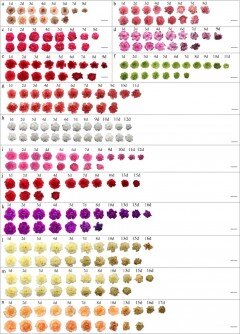Carnation Variety Variations in Response to Ethylene Treatment and Natural Vase Life Span
Carnation, scientifically known as Dianthus caryophyllus L., is a popular flower cherished for its beauty and fragrance. Despite its widespread cultivation, carnations encounter postharvest hurdles, notably linked to water scarcity and microbial proliferation.
Studies have emphasized the crucial impact of ethylene on the flower’s longevity, showcasing disparities in responsiveness and ethylene production levels among different carnation variants. Key genes like ACS and ACO, pivotal in ethylene synthesis, have been pinpointed, demonstrating the potential of manipulating ethylene production to enhance carnation vase life.
Nonetheless, a research gap exists concerning the postharvest physiological transformations in diverse carnation species, signifying a vital area necessitating further exploration to refine cut flower preservation techniques.
A research article by Ornamental Plant Research titled “Disparities in ethylene sensitivity, expression of ethylene biosynthetic genes, and longevity among carnation varieties” delves into this subject.
The investigation subjected 14 commercial carnation varieties to 10 μL/L ethylene gas for 4 hours to assess the impact of ethylene on the longevity of different variants. Results unveiled varying responses to ethylene, with ‘Master’ displaying the most substantial decline in vase life post-treatment. Conversely, ‘Snow White’ exhibited unchanged longevity, indicating minimal sensitivity to ethylene.
Moreover, water loss during different senescence stages in selected varieties illustrated that ethylene treatment hastened water depletion, particularly evident during complete wilting.
Measurements of ethylene release shed light on the ethylene production patterns of the varieties, showcasing diverse reactions, notably with ‘Master’ showcasing a distinct ethylene release peak at 24 hours, contrasting ‘Snow White’s’ lower ethylene sensitivity.
Gene expression analysis concentrated on DcACS1, DcACO1, DcEBF1/2, and DcERF-1, critical for ethylene synthesis and signaling. Remarkably, ‘Master’ exhibited a substantial surge in DcACS1 and DcACO1 expression post-ethylene treatment, while ‘Snow White’ displayed the least increase, aligning with their ethylene sensitivity levels.
To delve deeper into ethylene’s role in senescence, experiments involving transient silencing and overexpression targeting DcACS1 and DcACO1 genes were conducted. Silencing DcACS1 in ‘Master’ delayed senescence and preserved flower disk whiteness, while overexpressing DcACS1 expedited senescence.
Similar trends were observed with DcACO1, where silencing prolonged senescence and overexpression accelerated it, validating the pivotal role of these genes in carnation senescence.
In essence, this study underscores the intricate interplay between ethylene sensitivity, water regulation, and genetic elements in dictating the postharvest longevity of carnation blooms. It emphasizes the potential of genetic manipulation in extending vase life, offering insights for breeding resilient carnation varieties and setting the stage for future research in flower preservation techniques.
More information:
Min Wang et al, Differences in ethylene sensitivity, expression of ethylene biosynthetic genes and vase life among carnation varieties, Ornamental Plant Research (2024).
Citation:
Unraveling ethylene’s role in carnation postharvest life: Insights into varietal sensitivity and genetic regulation (2024, April 3) retrieved 3 April 2024 from https://phys.org/news/2024-04-unraveling-ethylene-role-carnation-postharvest.html
